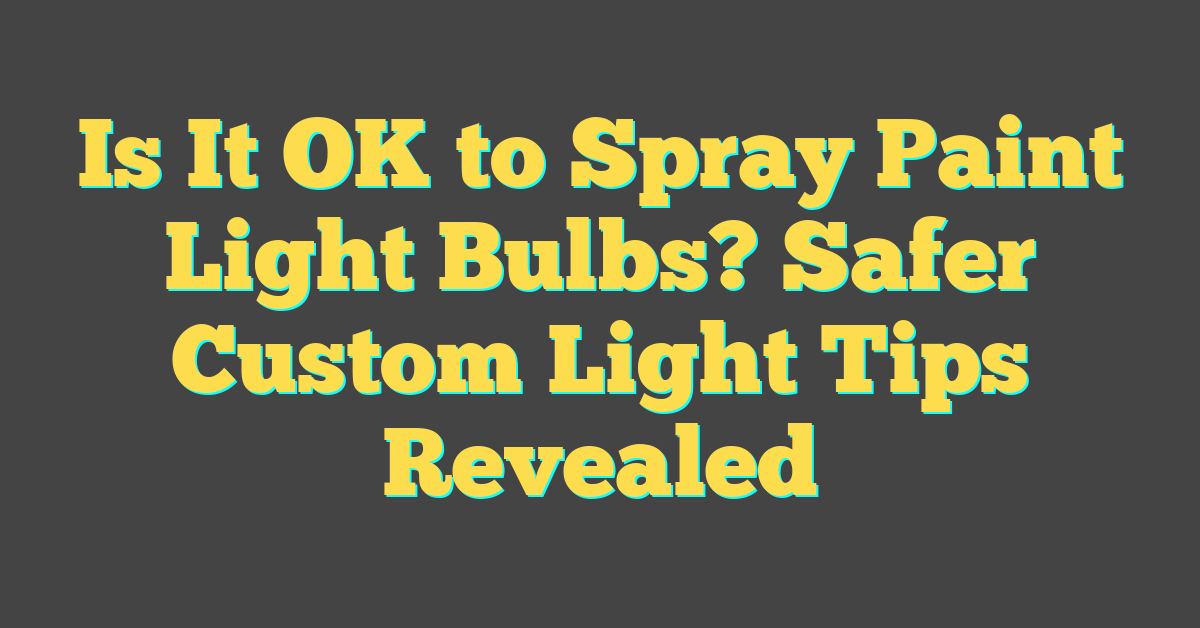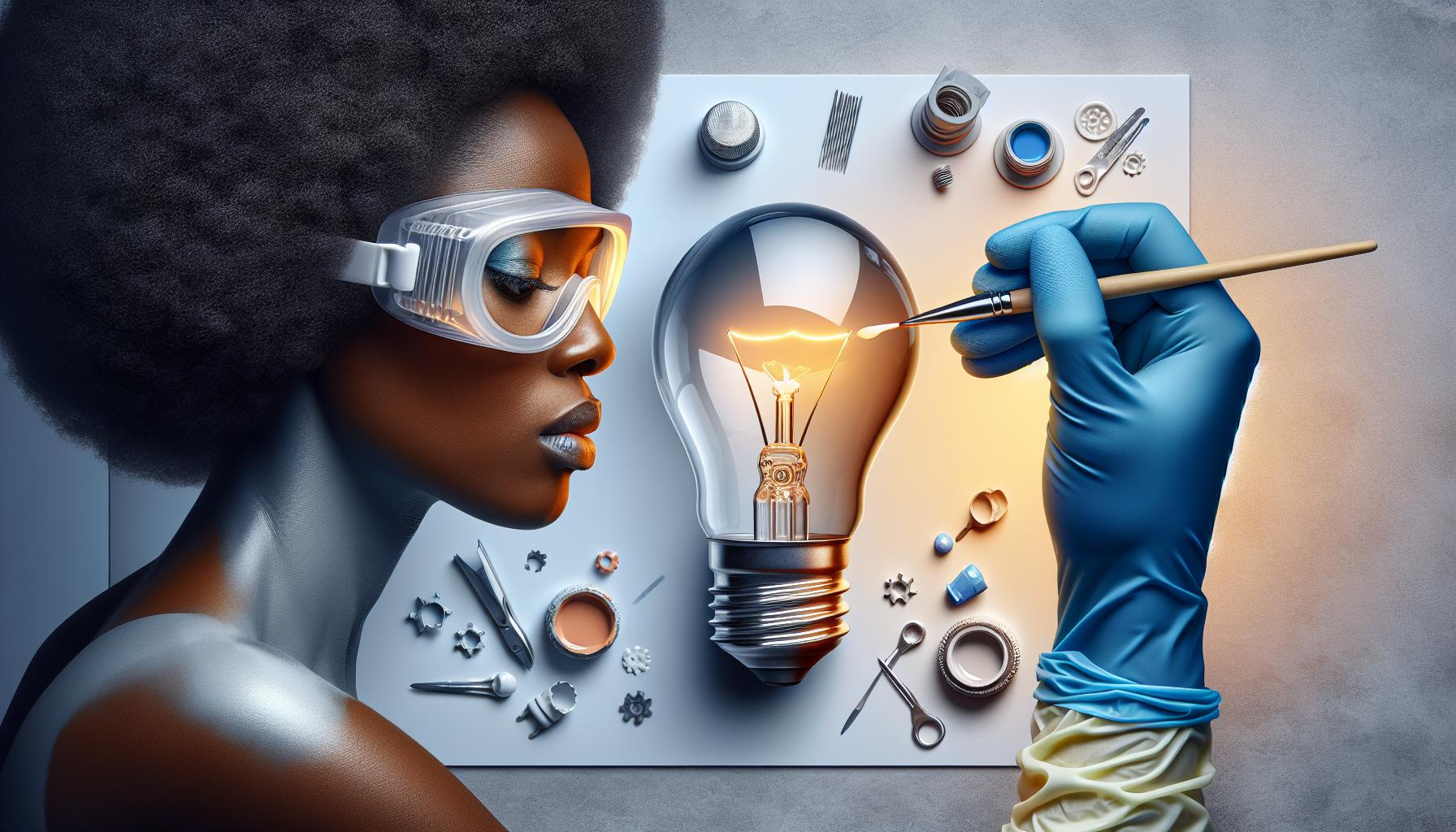Ever wondered if you can give those plain light bulbs a splash of color? It’s a tempting DIY project, right? You’re not alone in thinking that a little bit of spray paint could add a unique touch to your room’s ambiance.

Before you grab that can of paint and start your transformation, let’s dive into the nitty-gritty. Safety first! You’ll want to know if it’s a bright idea or a potential hazard waiting to happen.
What is Spray Painting Light Bulbs?
Spray painting light bulbs is a popular DIY technique that involves applying a coat of paint directly to the surface of a light bulb. This customization is often sought after not just to match a room’s decor but also to create ambient or mood lighting. Here’s what you need to keep in mind when you get the itch to add a splash of color to your lighting.
First, it’s essential to choose the right type of paint. High-heat spray paint is designed to withstand the high temperatures bulbs can emit. Using the wrong paint could lead to melting, peeling, or even a potential fire hazard.
Safety should be your paramount concern. You’re dealing with both electric components and chemicals, so ensure you’re taking the necessary precautions. Work in a well-ventilated area, wear protective gear, and avoid getting paint on the metal base of the bulb.
Let’s talk about the process. You’ll want to clean the bulb thoroughly, removing fingerprints and grease — a clean surface ensures better paint adhesion. After applying painter’s tape to areas you don’t want painted, like the bulb’s base, you’re ready to start the spray painting process. Remember to apply several thin coats rather than one thick coat to avoid drips and to achieve a more even finish.
Remember to let the paint cure completely before use. Skipping this step can lead to the paint cracking under the heat, ruining all your hard work.
The appeal of this project is understandable. You get to personalize your space and set a specific tone with colors that can affect the mood and aesthetics of a room. Imagine the possibilities: a soft pink glow for a cozy reading nook or a vibrant red for party vibes.
But before you let your creativity run wild, you must weigh the practical aspects. Beyond safety, think about the light output. Painting a bulb often means dimmer light, as the paint can act as a filter. This might be an effect you’re seeking, but if it’s functional lighting you’re after, this may not be the right avenue.
The Pros and Cons of Spray Painting Light Bulbs

As a light bulb and lighting aficionado, you know that ambiance is everything. When it comes to customizing your space, spray painting light bulbs can seem like a quick and creative solution. But before you shake that can of paint, weigh both sides of the coin.
Pros
Here are some compelling reasons to spray paint your light bulbs:
- Customization: You can match the light bulb color to your room’s color scheme, creating a coordinated look.
- Mood Lighting: A layer of paint can soften the glow of the bulb, perfect for setting a certain mood or ambiance.
- Cost-Effective: It’s a budget-friendly alternative to purchasing colored light bulbs or smart bulbs that change colors.
- Quick Update: Spray paint offers a rapid transformation, ideal for temporary setups like parties or events.
However, despite these attractive benefits, it’s vital to consider the drawbacks carefully.
Cons
When you’re looking into DIY lighting projects, here’s what might give you pause:
- Heat Retention: Paint can cause bulbs to retain more heat, potentially shortening their lifespan or leading to hazards.
- Diminished Brightness: The paint layer reduces light output, which could mean you’ll need more bulbs to achieve the same level of brightness.
- Uneven Application: It’s challenging to get a smooth, even coat, which could result in patches of light and dark or a less professional look.
- Durability Issues: The paint may not adhere well to the glass, leading to peeling or flaking over time.
- Safety Precautions: Working with paint and electrical components requires strict adherence to safety guidelines to prevent accidents.
Evaluating these pros and cons will help you make an informed decision about whether spray painting light bulbs is right for your project. Remember to consider the balance between aesthetic appeal and practical functionality as you plan your approach to modifying your home lighting.
Safety Concerns: Is it Dangerous to Spray Paint Light Bulbs?
« Are LED Light Bulbs Fluorescent? Debunking Myths & Comparing Benefits
What Light Bulbs Go in Salt Lamps? Unlock the Perfect Glow »

Safety should be your top priority when considering a project like spray painting light bulbs. While that burst of color can really set the mood, risk of fire hazard is something you can’t ignore. Light bulbs generate heat and spray paint can act as an insulator, trapping the heat and increasing the risk of the bulb shattering or even igniting.
First off, you should always use non-flammable, high-temperature paint. These are specifically formulated to withstand the heat generated by bulbs, so you won’t have to worry about the paint itself catching fire. Typically, these paints are used for items like grills or engines, but they can also be applied to your lighting project.
However, even with the right type of paint, stacking on layers can cause issues. Thick layers can prevent heat from escaping and it’s crucial to apply the paint thinly and evenly. Test your skills on a spare bulb to ensure you’ve got the hang of it before moving on to your actual project.
Bulbs with higher wattage produce more heat and thus present a greater danger. It’s a good idea to switch to LED bulbs if you’re determined to paint them. LEDs emit far less heat than their incandescent or halogen counterparts, making them a safer option.
Regarding durability, when light bulbs heat up and cool down repeatedly, this can cause the paint to crack and peel. In the worst-case scenario, flaking paint could land on a hot bulb and smolder.
| Safety Feature | Consideration |
|---|---|
| Type of Paint | Non-flammable, high-temperature paint |
| Application Method | Thin, even coats |
| Bulb Type | Prefer LED bulbs for less heat emission |
| Durability with Heat Cycles | Watch for cracking or peeling |
Lastly, ensure that your workspace is well-ventilated. Inhaling paint fumes can be harmful to your health, and you certainly don’t want to compromise your well-being for the sake of a DIY project.
Remember, tackling any home project—especially when electricity is involved—means putting safety first. Consider these points carefully while you get creative with your mood lighting.
Alternatives to Spray Painting Light Bulbs

While spray painting light bulbs can be a DIY enthusiast’s dream for customizing light fixtures, there are safer and more effective alternatives to achieve a similar effect. Colored light bulbs are the simplest solution, offering a variety of hues to set the mood you’re aiming for without the risks associated with paint. These bulbs are designed to emit specific colors, ensuring they’re safe and reliable for long-term use.
Lighting gels are another alternative that can impart color to your lights without altering the bulbs themselves. Commonly used in theatrical productions, these gels can be cut to fit your light fixture and are a perfect temporary solution for events or themed parties.
If you’re intent on a more hands-on approach, consider dyeing the glass of the bulb yourself. Various glass dyes are available that can be applied to create a stained-glass effect. Be diligent in selecting dyes that are suitable for high temperatures:
- Non-toxic
- Heat-resistant
- Transparent
As you embark on these creative endeavors, always prioritize your safety and the longevity of your lighting. Remember, LED bulbs offer the advantage of lower heat output, which pairs well with alternative coloring methods.
For those who love the DIY crafting process and yearn for truly unique lighting pieces, making your own lampshades or covers could be an exciting project. Utilize materials and fabrics that can withstand close proximity to a light bulb. This approach allows you to play with patterns and textures, giving you complete control over the diffusion and ambiance of the light.
Creating the ideal mood with your lighting doesn’t have to involve risks, and with a bit of ingenuity, you can achieve a stunning aesthetic safely and with great satisfaction. Always keep your workspace ventilated and free from flammable substances, regardless of which lighting project you tackle.
Conclusion
So you’ve got a range of safer, more effective ways to add color and personality to your lights without reaching for the spray paint. Whether you opt for colored bulbs, lighting gels, or even crafting your own lampshades, remember that safety and bulb longevity are key. And when in doubt, LED bulbs are your best bet for a cooler, less risky option. Just keep that workspace well-ventilated and steer clear of anything flammable. Happy customizing!
Frequently Asked Questions
Can I use spray paint on light bulbs?
No, using spray paint on light bulbs is not recommended due to safety hazards and the potential for reduced bulb longevity.
What are safer alternatives to spray painting light bulbs?
Safer alternatives include using colored light bulbs, applying lighting gels, dyeing the glass with glass dyes, or creating custom lampshades or covers that are heat resistant.
Why are LED bulbs recommended when customizing light fixtures?
LED bulbs are recommended because they generate less heat, making them safer and more suitable for use with decorative covers or dyes.
Is it safe to dye the glass of a light bulb?
Yes, but it is critical to use suitable glass dyes and follow safety instructions to avoid any hazards.
What should I keep in mind while customizing my light fixtures?
Always prioritize safety, ensure good ventilation, avoid flammable materials, and choose the right materials that can withstand the heat from the light bulb.




